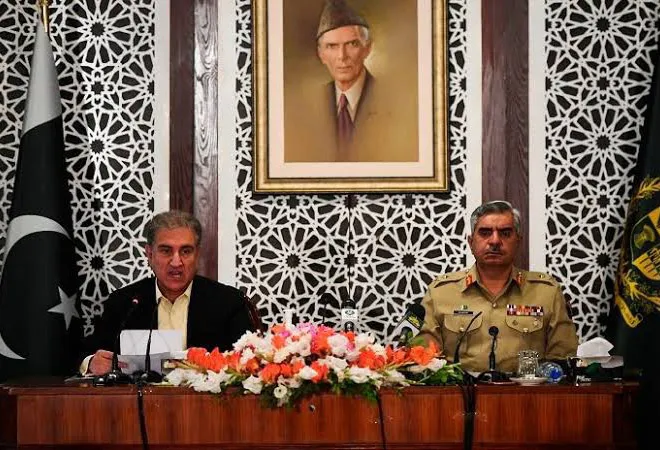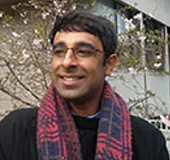-
CENTRES
Progammes & Centres
Location

On November 14, Pakistan released a dossier claiming that it has “irrefutable evidence” of Indian intelligence agencies’ involvement in its domestic turmoil. It termed such involvement as India’s “state-sponsored terrorism”. The world, Pakistan’s Prime Minister Imran Khan implored on Twitter, “in the face of this evidence, cannot remain indifferent or silent”.
Of the entire dossier about ten-pages are publicly available. The rest is being presented to international organisations such as the P-5, the OIC, the UN, and the FATF after the DG-ISPR Maj. Gen. Babar Iftikhar and Foreign Minister Shah Mahmood Qureshi presented select audio clips and pictures of alleged Indian operatives engaging with Pakistani militants.
India denied the allegations as being “fabricated” and a “figment of (Pakistan’s) imagination”. Indian experts who follow this space regularly highlighted a variety of aspects ranging from spelling mistakes, use of unverifiable information, and legal and bureaucratic inconsistencies, to elements where India’s secret involvement is indeed plausible.
This is not the first time Pakistan has released such a dossier.
It took inspiration from New Delhi’s systematic exposure of the Inter-Services Intelligence’ (ISI) involvement in cross-border terrorism and links with global jihadists, and came up with its own dossiers in 2009 and 2015. But unlike Indian dossiers that have helped New Delhi build international diplomatic pressure on Pakistan, the reverse has not occurred –and is unlikely to happen this time round either.
The question then is, why release another dossier if the previous ones have been ineffective, and why now? It is tempting to rubbish such dossiers given their contested forensic minutiae. But that misses the point. Even forensically dead dossiers have immense propaganda value for domestic and international audiences. Such narratives, once in the public domain, develop a life of their own.
Given India’s struggles with internal balancing in recent years and flare-up of communal violence in the national capital earlier this year, such dossiers intend to paint a particular picture that may complicate India’s diplomatic efforts vis-à-vis Pakistan in the long term. Chaperoned by Special Advisor to Prime Minister (SAPM) Moeed Yusuf who is invested in “correcting narratives” surrounding Pakistan –instead of changing the product– this dossier has served its purpose on the propaganda count.
Given India’s struggles with internal balancing in recent years and flare-up of communal violence in the national capital earlier this year, such dossiers intend to paint a particular picture that may complicate India’s diplomatic efforts vis-à-vis Pakistan in the long term
The dossier, coming soon after Yusuf’s much discussed interview to Karan Thapar in October, mobilised partisan public opinion that already favoured Pakistan’s military establishment. It also offers Islamabad a tool to counter international pressure on terror-financing while casting doubt on India’s role in securing regional peace and stability. But the real value the dossier is likely to generate for Pakistan is not necessarily in the diplomatic space but on the ground, and across the region. The timing and method of releasing this dossier offers critical clues.
Undoubtedly, effective propaganda resonates across audiences. From that perspective, this dossier does intend to create support for Pakistan’s cause in Washington D.C., especially within the team led by Democratic president-elect Joe Biden, as well as in other Western capitals and international platforms such as the UN, FATF, and the OIC. But Islamabad understands that this is unlikely to generate substantial diplomatic support for two reasons.
One, for most part of the Obama administration, when Biden was vice president, the CIA and ISI fought multiple covert battles. These battles came out in the open in 2011 with the Raymond Davis affair, and the eventual assassination of Osama bin Laden in Abbottabad. This history is too recent and fresh to convince Biden otherwise on the Pakistan question. Two, unlike the Cold War and the so-called Global War on Terror, wherein Pakistan was a central frontline state, India is more strategically consequential in the U.S.’ ongoing rivalry with China. The withdrawal from Afghanistan will further reduce Islamabad’s leverage over Washington D.C.
Equally, Pakistan’s rift with Saudi Arabia and the United Arab Emirates, and India’s increasing geopolitical value in Riyadh and Abu Dhabi makes it difficult for Islamabad to shore up international support –Turkish, Malaysian, and Chinese solidarity notwithstanding. In fact, after having let Pakistan go off the hook for years at end, many of these countries are unlikely to have leverage over India’s current strategy of coercion vis-à-vis its neighbour.
Similarly, the dossier allows a politically embattled Imran Khan and COAS General Qamar Javed Bajwa to paint all domestic dissenters and the political opposition as Indian proxies. But the argument that this is the central driver of releasing it now is not compelling. Rawalpindi has used the narrative of a “secret Indian hand” behind its domestic troubles for decades. It does not need a dossier on Indian covert warfare and spend precious diplomatic capital to hunker down on domestic dissent – it was doing that, and will continue to do that, anyways.
The dossier allows a politically embattled Imran Khan and COAS General Qamar Javed Bajwa to paint all domestic dissenters and the political opposition as Indian proxies. But the argument that this is the central driver of releasing it now is not compelling
The central audience of this dossier is indeed, India.
One, that Islamabad is committed to reducing India’s strategic footprint in Afghanistan in the coming months. The dossier was released just before Imran Khan’s visit to Kabul that intended to break the deadlock in Doha where the Afghan government is holding talks with the Afghan Taliban under Pakistan’s tutelage. It came in context of the US’ announcement of reduction of troops to 2,500 by January 2021, and a series of visits by senior Afghan officials to India, most of whom tried to convince New Delhi to open direct channels with the Afghan Taliban.
There have also been multiple assassination attempts in recent months against Afghanistan’s sitting vice president and former intelligence chief Amrullah Saleh, who is an ardent critic of Pakistan and a known ally of India. The length to which the dossier goes in attempting to expose a “nexus” between Indian and Afghan intelligence agencies is a signal of intent to actively target Indian interests in the war-torn country.
To be clear, given the tormented relationship that Pakistan has with both India and Afghanistan, Kabul and New Delhi indeed cooperate in the security sector. But Pakistan’s exaggeration that India runs 66 militant camps on Afghan soil, or helped fund the Tehrik-e-Taliban Pakistan (TTP), is not just an insult to the collective intelligence of the NATO machinery that fought this war for two decades and found nothing of the sort, but also a lethal scene-setter for unleashing targeted violence against Indian officials, interests, and installations in Afghanistan.
Scholars of secrecy in international politics have maintained that to expose the covert campaigns mounted by an adversary is an escalatory step, as it bind the leaders of the country that is taking such a step to counter these efforts. This dossier, coupled with Yusuf’s pre-emption of a back-channel during the interview with Thapar, not only kills the scope for any conversation between India and Pakistan, but puts a premium on retaliatory escalation at a moment when India is militarily tied down on the China front.
Pakistan might even be banking on lack of action by big powers and international institutions in pressuring India. In Islamabad’s eyes, the act of supplying a dossier and seeking international support frees it to undertake offensive action against India, and justify it as self-defence. Munir Akram, Pakistan’s envoy to the UN, made it a point to inform UN Secretary General Antonio Guterres when presenting the dossier that Islamabad reserved the right to “act in self-defence” against India’s alleged aggressions.
Pakistan might even be banking on lack of action by big powers and international institutions in pressuring India. In Islamabad’s eyes, the act of supplying a dossier and seeking international support frees it to undertake offensive action against India, and justify it as self-defence
This is time-tested script. In and around 2008-9, before and after circulating a dossier that no one took seriously, the ISI successfully targeted Indian embassy, consulates, officials, and even guest houses in Kabul where Indians resided. Indian developmental projects were not left behind either. Pakistan also ran an ultimately ineffective propaganda campaign that India operated 22 consulates in Afghanistan.
All of it was meant to signal India to get out of Afghanistan.
It occurred at a moment when London was paving diplomatic ground for negotiations with the Afghan Taliban –an idea that was baptised at the January 2010 Lancaster House conference– but failed to make serious headway. This was also a moment when London, much to New Delhi’s chagrin, was invested in questioning India’s presence and intent in Afghanistan on Pakistan’s behest. That’s not the case today, but there is a history to this episode that Pakistan is likely to be drawing inspiration from.
Two, perhaps the more dangerous signal is the opportunity that Pakistan sees in the deepening communal fissures within India. In fairness, it is unlikely that India imminently faces a serious strategic threat from home-grown Islamists. But with growing signs of Hindu nationalism, the recent communal violence in the national capital, and a systematic assault on interfaith marriages and practices, there is increasing concern in India’s security corridors about Pakistan –and China– exploiting communal fissures in the months and years to come.
Such concerns, as recent scholarship demonstrates, may not be ill-founded, even if they are not acute. After all, there is a reason why the Ministry of Home Affairs (MHA) led by Amit Shah, recently approved a study to analyse radicalisation in Jammu & Kashmir, Maharashtra, Assam, and Kerala. Of course, it remains unclear –perhaps unlikely?– if this study will include radicalisation across the religious, ethnic, and ideological spectrum. But the four states it has opted to begin its analysis with are focused on radicalisation of Muslim youth.
The option of fuelling insurgency in Kashmir has become unviable for the ISI given India’s heavy security blanket since the revocation of Article 370. This, in combination with Pakistan’s diminished diplomatic weight in international platforms, and intense firing across the Line-of-Control, the ISI is likely to view India’s communal fissures space as an attractive and exploitable cleavage. It might even receive covert Chinese support on this count as some within India’s security corridors are hinting towards in private.
Whether this threat materialises is still to be seen, but it is clear that there will be limits to how far India can use a securitised approach to deal with such radicalisation and potential external interference. The key might just lie in better internal balancing, even if done for geopolitical reasons instead as a matter of principle by a Hindu nationalist government.
The views expressed above belong to the author(s). ORF research and analyses now available on Telegram! Click here to access our curated content — blogs, longforms and interviews.

Avinash Paliwal is an Associate Professor of International Relations at SOAS University of London and author of My Enemys Enemy: India in Afghanistan from the ...
Read More +